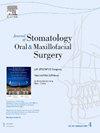Survey on complications of Orthognathic surgery among oral and maxillofacial surgeons
IF 2
3区 医学
Q2 DENTISTRY, ORAL SURGERY & MEDICINE
Journal of Stomatology Oral and Maxillofacial Surgery
Pub Date : 2025-04-21
DOI:10.1016/j.jormas.2025.102387
引用次数: 0
Abstract
The purpose of this study is to investigate the rates of complications encountered by oral and maxillofacial surgeons who actively perform orthognathic surgeries in Türkiye intraoperative and postoperative periods. Sixty oral and maxillofacial surgeons, 39 male and 21 female, who actively performed orthognathic surgeries in Türkiye were included in this cross-sectional study which was conducted with a survey. A 19-item survey form was created and sent to the participants via the Google Forms platform. The survey included questions about complications in sagittal split ramus osteotomy, vertical ramus osteotomy, subapical osteotomy, genioplasty, LeFort 1 osteotomy, and bimaxillary surgery. In the interpretations of the results of the statistical analyses, p < 0.05 was accepted as the threshold for statistical significance. It was found that 46.7 % of the participants had 1–5 years of orthognathic surgery experience. The most frequently experienced complication in orthognathic surgeries of the mandible was nerve damage. Nerve damage was also the most frequently experienced complication in sagittal split ramus osteotomy and bimaxillary surgery procedures, observed at rates of 82.5 % and 76.8 %, respectively. Condylar resorption, which is complication rarely encountered in the postoperative period, was encountered by 14 participants. The rate of participants with LeFort 1 osteotomy experience was 98.3 %, and the most frequently seen complication in this type of surgery was bleeding at a rate of 69 %. According to the results of this study, oral and maxillofacial surgeons in Türkiye encountered similar complications in orthognathic surgeries. Despite cases of severe complications during and after surgeries of the maxilla and mandible, the low number of these complications makes orthognathic surgeries safe procedures.
口腔颌面外科正颌手术并发症调查。
本研究的目的是调查积极实施正颌手术的口腔颌面外科医生在术中和术后所遇到的并发症的发生率。本横断面研究采用问卷调查的方式进行,包括60名口腔颌面外科医生,其中男性39名,女性21名。创建了一个包含19个项目的调查表格,并通过谷歌Forms平台发送给参与者。调查内容包括矢状分支截骨术、垂直分支截骨术、根尖下截骨术、膝成形术、LeFort 1截骨术和双颌手术的并发症。在对统计分析结果的解释中,接受p < 0.05作为统计显著性的阈值。46.7%的参与者有1-5年的正颌手术经验。下颌正颌手术中最常见的并发症是神经损伤。神经损伤也是矢状分叉支截骨术和双颌截骨术中最常见的并发症,分别为82.5%和76.8%。14例患者出现术后少见的髁突吸收并发症。采用LeFort 1型截骨术的患者比例为98.3%,此类手术最常见的并发症是出血,发生率为69%。根据本研究的结果,台湾的口腔颌面外科医生在正颌手术中遇到了类似的并发症。尽管在上颌和下颌骨手术期间和之后会出现严重的并发症,但这些并发症的发生率很低,因此正颌手术是安全的。
本文章由计算机程序翻译,如有差异,请以英文原文为准。
求助全文
约1分钟内获得全文
求助全文
来源期刊

Journal of Stomatology Oral and Maxillofacial Surgery
Surgery, Dentistry, Oral Surgery and Medicine, Otorhinolaryngology and Facial Plastic Surgery
CiteScore
2.30
自引率
9.10%
发文量
0
审稿时长
23 days
 求助内容:
求助内容: 应助结果提醒方式:
应助结果提醒方式:


